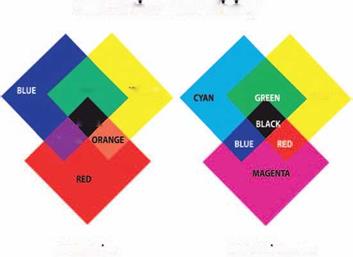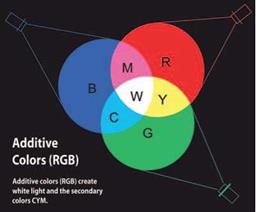by Joseph N. Tawil, President, GAMPRODUCTS, Inc.
Color mixing with lights is called additive color mixing (Figure 4.1). This tricolor mixing theory was proposed by Sir Thomas Young in the early 1800s, and it is the basis for all film and video color systems today. Young discovered that by mixing red, blue, and green light, he could make the most of the colors in the visible spectrum. Young determined that red, green, and blue were the ideal primary colors of light because they allow for the widest variety and create a reasonable white. Red, green, and blue are three colors that are widely separated from each other. Because of this, they will combine to make many other colors, including, in the right circumstances, white.
Combining two primary colors creates a secondary color that is a complement of
|
FIGURE 4-1: ADDITIVE COLORS |
the third primary (complement, as in completes). For example, by combining red and blue, you get magenta and other colors in the violet and pink range. Combining blue and green generates cyan (blue green) colors. Combing red and green creates yellow and other colors in the orange range.
Complementary colors are also called secondary colors. Violets and pinks are complementary to the primary color green because they contain red and blue. Oranges and yellows are complementary to the primary color blue because they contain red and green.
Tricolor mixing is illustrated in Figure 4.1.
It is interesting to note that the complementary colors (or secondary colors) created in the additive color-mixing process—cyan, yellow, and magenta—are the primary colors of the subtractive colormixing system. Obviously, this in not an accident, and the two theories do tie together.
Subtractive Color: Subtractive color filtering (Figure 4.2) is something all of us
 Subtractive Color Mixing
Subtractive Color Mixing
|
|||
|
|||
|
|||
|
|||
|
|||
|
|
||
|
|||
|
|||

![]()
have experienced in elementary school, where we have mixed paints to make a variety of colors. Later, we will. It’s possible to read art books where painters talked about mixing primaries to make different colors. The primaries are often described in these art books as red, yellow, and blue. Filmmakers, however, see the subtractive color-mixing primaries described as yellow, cyan, and magenta. Using the same language to describe primary colors in both the subtractive and additive color-mixing processes causes a great deal of confusion. Printers and filmmakers define the subtractive primary colors more accurately as cyan, yellow, and magenta (CYM), separating them from the additive color process. In subtractive color mixing, as we mix the primary colors of paints, inks, or filter emulsion layers, the resulting color gets darker and darker, and eventually black.
Subtractive color mixing is what we do when mixing makeup pigments, as opposed to the Lighting Department, which will use the additive process for color mixing. In other words:
Additive Color: In the additive colormixing process, we are adding primary colors to come to white light. In the subtractive color-mixing process, we are mixing the primary colors to come to black.
When the artist knows that the word “additive” means mixing light to get a color, and the word “subtractive” is mixing pigments (makeup), all the mystery about a light source is better understood.
Correction Filters: The primary function for correction filters is to balance to a given light source. The two points of balance most often used are 3200K (or tungsten), and daylight (usually 5600K). Most film and
![]()
![]() television is divided between the two. For example, if you are shooting in an office with sunlight coming through the window, you will want to correct for one or the other. You either warm the sunlight toward tungsten, or you raise the apparent color temperature of the incandescent to daylight. The Makeup Artist needs to understand that the light itself does not affect the makeup, but how the lights are manipulated by additive color mixing with the use of gels and filters in front of the light source does.
television is divided between the two. For example, if you are shooting in an office with sunlight coming through the window, you will want to correct for one or the other. You either warm the sunlight toward tungsten, or you raise the apparent color temperature of the incandescent to daylight. The Makeup Artist needs to understand that the light itself does not affect the makeup, but how the lights are manipulated by additive color mixing with the use of gels and filters in front of the light source does.
Fluorescent Light: This type of light is problematic because of the green spikes attributed to it. Manufacturers make two kinds of fluorescents: warm and cool. The warm leans toward tungsten, and the cool leans toward daylight. Other problems with fluorescents are inconsistent lamp manufacturing, aging lamps that are still being used, and the fact that certain colors are always missing from the spectrum. If you find yourself on a shoot with fluorescents as a light source, and you need to match or create a specific color (let’s say lipstick), take a test photo before the shoot begins.
Video Lights: Video often uses softer lights (soft boxes) for indoor interviews. Film and video usually work with HMI (hydrargyrum medium-arc iodide) if shooting outside in the daylight or with incandescent in the studio. Be prepared to make adjustments to the makeup if the actor is being moved from an interior shot to an exterior shot. There is a big difference in the visual perception of the colors when incandescent lights are used inside to do your makeup, and then you go outside and shoot in daylight or with HMI lights.
PRO TIP
If the actor is going back and forth between interior and exterior shots, and there is no time for adjustments, choose the situation that is the longest on screen, or the most important for dramatic content, for your makeup to be the best. This works for film, television, and stage.
—Gerd Mairandres, Wigmaster, San Francisco Opera
|
|
Stage Lighting: Stage lighting uses light for different reasons. There are a wide range of colors used theatrically. When you’re working in the theatre, the lighting designer is there during the technical/rehearsal period, and their color design can be discussed then.
The theatre usually uses an incandescent source unless you’re looking at a xenon follow spot or HMI follow spot, which is very close to daylight, and much bluer in its energy. The makeup is decided by how bright the light will be, how large is the stage being lit, what color gels or filters are being used to light the actors or objects onstage, and how the light is used around the stage.
Photography: Photography uses light to create greater dimension, to highlight different areas, and to reduce or magnify details. Natural light is often used to create moods. Artificial lights are used to control different shooting situations. Tungsten or incandescent lighting is most often used.

